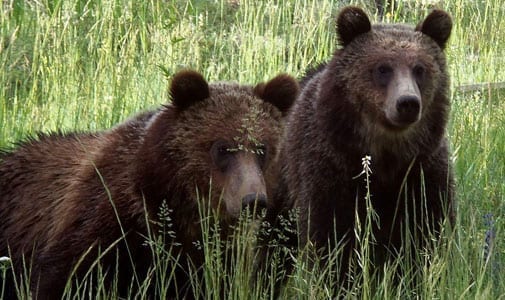“Bear Friendly” means allowing every bear to retain its wild and free nature.

Young grizzly bears
Spring is the time when bears and cubs emerge from their winter dens. Grizzly and black bears are active from early spring through late fall in the Yellowstone area. Please enjoy our wildlife, especially bears, safely and responsibly.
Being bear-friendly in Montana is a commitment. It may mean sacrificing the opportunity to see a bear or take pictures of it—for the welfare of the bear. It means taking steps to prevent bears from finding sources of food on your property or when you are out camping.
View wildlife from the safety of your car or from a safe distance. Wild animals are wild and unpredictable, even though they may seem calm. Stay at least 100 yards away from bears and wolves and at least 25 yards away from other large animals including elk and bison.

Once a bear is food-trained, it is often impossible to un-train them. That is why biologists so often say a fed bear is a dead bear. Never approach, touch or feed wildlife, even when the animal does not seem to be threatened by your presence. Animals become dependent on human food may become aggressive toward people and have to be killed. Keep all food, garbage, or other smelly items packed away when not in use. If you plan to hike, be sure to go with a friend, make noise on the trail (talking or clapping), carry bear spray, and know how to use it. Bear bells are a favorite for making noise while you walk!
Your vigilance in keeping your residence and outdoor camps “Bear Friendly” can make all the difference in helping keep Montana’s grizzly and black bears wild and free.
Montana is a place where a bear is not viewed as entertainment but as a wild animal that shares its habitat with humans. Please make the commitment now to share bear country in a way that is respectful of bears and of the safety of other humans.
Don’t Feed Bears!
It is unlawful to intentionally, or to inadvertently feed bears. Those who do will be warned and possibly cited.
Recommendations for Recreating Safely in Bear Country:
- Inquire about recent bear activity in the area.
- Carry and know how to use bear pepper spray for emergencies.
- Stay on trails or rural roads.
- Make your presence known by talking, singing, carrying a bell, or other means, especially when near streams or in thick forest where visibility is low. This can be the key to avoiding encounters. Most bears will avoid humans when they know humans are present.
- Let someone know where you are going and when you plan to return.
- Travel in groups of three or more people whenever possible and plan to be out in the daylight hours.
- Watch for signs of bears such as bear scat, diggings, torn-up logs and turned over rocks, and partly consumed animal carcasses.
- Keep children close.
- Use caution in areas like berry patches where bears occur.
- Don’t approach a bear; respect their space and move off.
Campers
- Camp away from trails and areas where you see grizzly signs.
- Keep a clean camp at all times. Keep tents and sleeping bags free of odors, especially when you’re away from your campsite or turning in for the night.
- Avoid cooking smelly foods.
- Bears have incredibly strong senses of smell. Hang all food, trash and other odorous items well away from camp and at least 10′ above ground and 4′ from any vertical support, or store in a bear-proof container. Livestock feed should be treated the same as human food.
- Don’t sleep in the same clothes you wore while cooking or eating.
The Custer-Gallatin National Forest Food Storage Order requires that all unattended food, refuse, and attractants be acceptably stored at all locations in the Greater Yellowstone Ecosystem of the Custer-Gallatin National Forest. Acceptably stored means placing all attractants in hard-sided vehicles or certified bear-resistant containers, or utilizing methods that meet the requirements outlined in the Interagency Grizzly Bear Committee Approved Bear Resistant Products List. The list can be found at here. The Food Storage Order defines appropriate methods for acceptably storing and possessing food, refuse and other attractants, including animal carcasses.
Anglers
- Don’t leave fish entrails on shorelines of lakes and streams. Sink entrails in deep water. If you don’t properly dispose of entrails you increase danger to yourself and to the next person to use the area.
Hunters
Hunting in bear country requires special equipment, skills and precautions. Here are some tips to properly prepare for your hunt:
- Carry bear pepper spray (at least 1 canister per hunter) and know how to use it;
- Have pulley systems & ropes (for hanging game & food storage);
- Have a drop cloth for relocating game;
- Carry gloves & apron for handling game;
- Carry a charged cell phone or hand-held 2-way radio and first aid kit;
- Let someone know where you are and when you plan to return;
- Know the requirements of Food Storage Order; and
- Pick up a Motor Vehicle Use Map for the area you are hunting in from the nearest Forest Service office.
Additional resources:
Sources: bebearware.org, fwp.mt.gov, www.fs.usda.gov/gallatin.